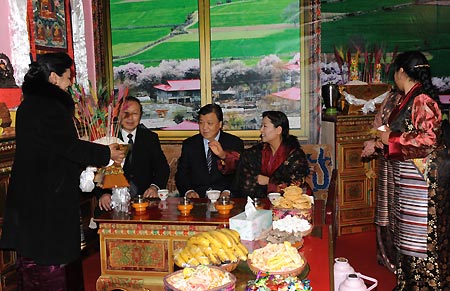|

|
|
Liu Yunshan, head of Chinese Communist Party Central Committee Publicity Department, Du Qinglin, the vice chairman of the National Committee of the Chinese People's Political Consultative Conference and head of the United Front Work Department of the Communist Party of China Central Committee, attend an exhibition marking the 50th anniversary of the Democratic Reform in Tibet Autonomous Region in Beijing, capital of China, Feb. 24, 2009. |
Another exhibition showing the changes that have taken place in Tibet over the past 50 years has opened in Beijing.
Liu Yunshan, head of the Communist Party of China Central Committee Publicity Department, said: "In the past 50 years, with the help of the central government, people in Tibet have developed a great passion to build new lives for themselves."
The exhibition is being held to commemorate the 50th anniversary of Tibet's democratic reforms, he said.
"Tibet is an inalienable part of Chinese territory," he said.
More than 600 exhibits that tell the history of Tibet will be on show over the next two months, Liu said.
Liu Xinning, 77, a former journalist, visited the exhibition with his wife yesterday.
|

|
|
Liu Yunshan, head of Chinese Communist Party Central Committee Publicity Department, attends an exhibition marking the 50th anniversary of the Democratic Reform in Tibet Autonomous Region in Beijing, capital of China, Feb. 24, 2009. |
"I wanted to learn about the history of Tibet, which is a holy territory in my country. The secessionists that spoke out after the riots last year should come and see the exhibition."
Cai Xiang, 22, a Tibetan student from the Minzu University of China, said: "I was born and grew up in Sichuan province and don't know the history of Tibet. But this exhibition told me about the reforms."
"I hope Tibet becomes more prosperous in the future, so people can live better lives," he said.
In 1951, the central and Tibetan governments signed the 17-Article Agreement to liberate the Chinese region. In 1959, the ruling elite of Tibet staged an armed rebellion in Lhasa.
The central government disbanded the local government of old Tibet and crushed the rebellion after a two-year conflict, paving the way for democratic reform.
Last year, riots broke out in Lhasa, ahead of the Beijing Olympics.
|

|
|
A guide introduces a photo in an exhibition marking the 50th anniversary of the Democratic Reform in Tibet Autonomous Region in Beijing, China, Feb. 24, 2009. |
"Now Tibet is stable and the social order is calm. Tibetans in areas that celebrate the New Year at this time are going ahead with celebrations," Foreign Ministry spokesman Ma Zhaoxu told a regular briefing yesterday.
"The Dalai Lama clique's attempt to spread rumors to destroy Tibet's stability will fail," he said.
(China Daily February 25, 2009)